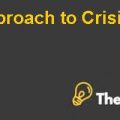Tailoring Your Strategy to Fit the Culture Case Study Help
Introduction
The case discusses the strategies that help the organization fit in a global culture by implementing a global strategy. However, implementing and adopting new global strategies are considered to be very difficult at the time of expanding business globally. The key issue that organization faces are they use or implement their existing regional or local strategy during global expansion which ultimately put a bad impact and create various other challenges for the organization.
Because their existing strategy is used to attract or gain local consumers, which is not considered to be appropriate for global consumers. Moreover, there is an example that if U.S based organization wants to expand its business in China there is a need to first recognize the Chinese culture and also needs to accept the behavior of people in China.
The second key issue is the mindset of managers because the locally based organization manager’s not consuming an open mindset for the global market. These managers are not able to provide their work internationally because of their closed mindset, which considers being inappropriate for the entire global culture. However, if any organization opens another factory in any other country and appoints a regional manager to lead the factory then ultimately operations in the factory are destined to fail because of unsuitable leadership skills and strategy.
To reduce these issues and failures there is a need for an organization to tailor their strategy to fit the culture that eventually helps them to get success in the global market. By using the appropriate leadership strategies organization becomes the leader in the global market and can adjust itself in any culture. It also helps the organization to understand the needs and trends of the new culture and makes them able to proceed with their work on it.
Situational Analysis
This analysis helps to understand the various factors and dimensions involved in the process of adapting new culture. It helps the organization to understand the global strategies and their implementation for global expansion. This analysis also identifies the impact of the cultural dimensions on the organization's expansion process.
Dimensions of Culture
Culture is considered an extensive and multipart concept, which includes different phases of human life like values, beliefs, behavior, and norms. Culture can be defined as the shared patterns of beliefs, values, behaviors, and artifacts that characterize a group or society. Geert Hofstede is a “Dutch Sociologist”, he characterized the national culture according to five key dimensions in his seminal study.
He developed a framework for understanding cultural differences based on his research on the attitudes and values of people in different countries. These key dimensions are accepted by organizations globally and widely. Hofstede's cultural dimensions theory identifies five dimensions of culture that can be used to compare and contrast cultures.
Power Distance
This dimension mentions the range to which individuals in a culture receive and presume supremacy variances and inequalities among individuals and groups. It mentions the level to which fewer controlling associates of a culture receive and presume an unsatisfactory circulation of supremacy. In high power distance civilizations, there is a better recognition of hierarchy and specialist structure, where people with power are treated with deference and respect.
Meanwhile, in low power distance societies, there is more equality and decentralization of power, where people are expected to follow orders without question. In contrast, societies with low power distance tend to be more democratic, with power distributed more equally and people treated with more respect regardless of their status.
For example, in countries like China, Malaysia, and Saudi Arabia, there is a high power distance where authority is respected and people are expected to follow rules and accept hierarchy. On the other hand, countries like Sweden and Norway have low power distance where people are encouraged to challenge authority and have more equal relationships.................
Tailoring Your Strategy to Fit the Culture Case Study Help
This is just a sample partial case solution. Please place the order on the website to order your own originally done case solution.













